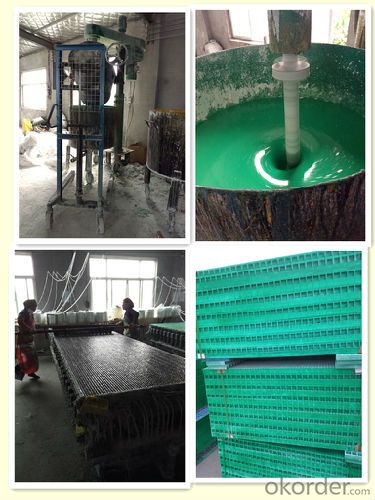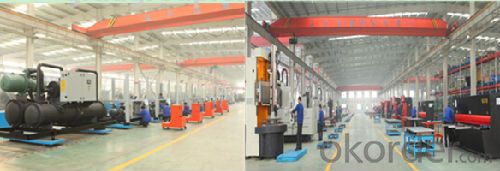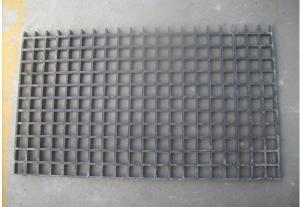FRP Molded Grating /GRP Grating / FRP Grating on Best Sales with All kinds of Colors
- Loading Port:
- China main port
- Payment Terms:
- TT or LC
- Min Order Qty:
- 100 m²
- Supply Capability:
- 5000000 m²/month
OKorder Service Pledge
OKorder Financial Service
You Might Also Like
FRP Molded Grating is a structural panel which uses high-strength E-Glass roving as reinforcing material, thermosetting resin as matrix and then casted and formed in a special metal mold. It provides properties of light weight, high strength, corrosion resistance, fire resistance and anti-skid. FRP Molded Grating is widely used in oil industry, power engineering, water & waste water treatment, ocean survey as working floor, stair tread, trench cover, etc. and is an ideal loading frame for corrosion circumstances.
Feature
Corrosion Resistance
Fire Resistance
Light Weight & High Strength
Safety & Anti-slip
Electrical Insulating
Aging Resistance
Specification
Advantage
coated with prevent aging layer
excellent insulating performance
no maintenance
high strength
long service life
easy installation
Application
Power plants, substation equipment enclosures, antimagnetic, anti-static,to prevent small animals into the equipment failure, as there is electricity facilities and without power interval intervals.
- Corrosive chemical industry equipment around the fence
All kinds of building maintenance section
FAQ
1. How about the documents after shipment?
After shipment, we ll send all original documents to you by DHL, including Packing List.Commercial Invoice, B/L, and other certificates as required by clients.
2. Do You Arrange Shipment?
Yes, dear esteemed customers, for FOB or CIF price, we will arrange shipment for you. For EXW price, clients need to arrange shipment by themselves or their agents.
3. How is the package?
Usually, we arrange the standard out-package for exporting.
PROCESS

FACTORY


- Q:Can FRP pultrusion profiles be used in the telecommunications and data communication industry?
- Yes, FRP pultrusion profiles can be used in the telecommunications and data communication industry. These profiles offer several advantages such as high strength-to-weight ratio, corrosion resistance, and electrical insulation properties. They can be used for applications such as cable trays, antenna supports, equipment enclosures, and infrastructure components, providing a durable and reliable solution for the industry's needs.
- Q:Can FRP pultrusion profiles be used in water treatment plants?
- Indeed, water treatment plants can utilize FRP (Fiber Reinforced Polymer) pultrusion profiles. The utilization of FRP pultrusion profiles in this industry brings forth numerous advantages that render them highly suitable. To begin with, FRP pultrusion profiles possess exceptional resistance to corrosion. Given the aggressive environments found in water treatment plants, where exposure to chemicals and moisture is common, the traditional materials like steel are prone to corrosion and degradation. However, FRP pultrusion profiles are immune to corrosion, making them an ideal choice for water treatment applications. Moreover, FRP pultrusion profiles exhibit remarkable strength-to-weight ratios. This implies that they offer superior structural integrity while being lightweight, rendering them easier to handle and install within water treatment plants. Additionally, their high strength enables them to endure the loads and pressures typically encountered in these environments. Furthermore, FRP pultrusion profiles are non-conductive of electricity. This feature is particularly advantageous within water treatment plants where there may be a necessity to isolate electrical equipment or components to prevent short circuits and safeguard personnel. FRP profiles provide a safe and dependable solution in such cases. Lastly, FRP pultrusion profiles possess a long service life and necessitate minimal maintenance. They do not rot, rust, or corrode, ensuring durability and longevity even in harsh water treatment conditions. This reduces downtime and maintenance costs, making FRP profiles a cost-effective choice for water treatment plant applications. All in all, due to their corrosion resistance, high strength-to-weight ratio, electrical non-conductivity, and long service life, FRP pultrusion profiles are an exceptional option for utilization in water treatment plants. Their usage can contribute to enhanced efficiency, reduced maintenance, and increased durability in water treatment processes.
- Q:How do FRP pultrusion profiles perform in earthquake-prone areas?
- FRP (Fiber Reinforced Polymer) pultrusion profiles perform exceptionally well in earthquake-prone areas due to their inherent properties. The high strength-to-weight ratio of FRP materials provides excellent resilience against seismic forces. Additionally, FRP pultrusions have high flexural strength, which enables them to withstand bending and torsional loads during earthquakes. Moreover, FRP profiles are corrosion-resistant, making them ideal for long-term durability in areas prone to seismic activity. Overall, FRP pultrusion profiles offer a reliable and robust solution for structural applications in earthquake-prone regions.
- Q:What types of materials are commonly used in FRP pultrusion?
- Fiber Reinforced Polymer (FRP) pultrusion is a manufacturing process that involves pulling continuous fibers through a resin bath and then through a heated die, resulting in a composite material with high strength and stiffness. Various types of materials are commonly used in FRP pultrusion, depending on the specific application and desired properties. 1. Fibers: The most commonly used fibers in FRP pultrusion are fiberglass (glass-reinforced polymer) and carbon fibers. Fiberglass is cost-effective, lightweight, and offers good strength and corrosion resistance. Carbon fibers, on the other hand, provide exceptional strength, stiffness, and lightweight properties but are more expensive. 2. Resins: The resin matrix used in FRP pultrusion provides the material with rigidity and protection against environmental factors. Polyester resin is the most common resin used due to its low cost, ease of handling, and good mechanical properties. Vinyl ester resin is another popular choice, offering improved chemical resistance and heat tolerance compared to polyester. Epoxy resin is used when high strength and durability are required. 3. Additives: Various additives can be incorporated into the resin matrix to enhance specific properties of the FRP pultruded product. UV stabilizers are commonly used to protect against ultraviolet degradation. Flame retardants can be added to increase fire resistance. Other additives like pigments, fillers, and mold release agents may also be used to achieve desired aesthetics and processing characteristics. By selecting the appropriate combination of fibers, resins, and additives, FRP pultrusion can produce a wide range of composite materials with tailored properties to meet specific application requirements. This versatility in material selection is one of the key advantages of FRP pultrusion, making it suitable for a variety of industries such as construction, infrastructure, aerospace, automotive, and marine.
- Q:Is the test standard for FRP pultruded profiles and FRP gratings the same?
- Different process, production, different uses, testing standards, of course, there are differences.
- Q:Can FRP pultrusion profiles be used in aerospace applications?
- FRP pultrusion profiles are applicable in aerospace applications. They possess numerous advantages that render them suitable for use in this field. Firstly, their exceptional strength-to-weight ratios are crucial in the aerospace industry as they contribute to weight reduction and fuel efficiency improvement. Secondly, FRP materials display high resistance to corrosion, making them suitable for enduring exposure to harsh environments like high altitudes and extreme temperatures. Additionally, FRP pultrusion profiles provide design flexibility, allowing for the production of intricate shapes and geometries. This flexibility enables aerospace engineers to customize the profiles according to specific requirements and optimize their performance. Moreover, FRP materials exhibit low thermal conductivity, which aids in insulation applications and minimizes heat transfer. Lastly, FRP pultrusion profiles have demonstrated commendable fatigue resistance, a crucial factor for aerospace applications subjected to cyclic loading. Overall, these properties establish FRP pultrusion profiles as a viable option for various aerospace components, including structural members, interior parts, and electrical enclosures.
- Q:Are FRP pultrusion profiles resistant to chemicals used in food packaging?
- Yes, FRP pultrusion profiles are generally resistant to the chemicals commonly used in food packaging. The combination of fiberglass reinforcement and resin matrix used in FRP profiles provides excellent chemical resistance, making them a suitable choice for applications involving contact with food packaging chemicals. However, it is always recommended to consult with the manufacturer or supplier to ensure specific compatibility with the chemicals involved.
- Q:Can FRP pultrusion profiles be used in the construction of pedestrian bridges?
- Yes, FRP (Fiber Reinforced Polymer) pultrusion profiles can be used in the construction of pedestrian bridges. FRP pultrusion profiles offer several advantages that make them suitable for bridge construction. Firstly, FRP pultrusion profiles are lightweight yet extremely strong and durable. This makes them ideal for use in pedestrian bridges where weight considerations are important. The lightweight nature of FRP profiles also makes transportation and installation easier and more cost-effective. Secondly, FRP pultrusion profiles are corrosion-resistant, which is a crucial factor in bridge construction. Unlike traditional materials like steel or concrete, FRP does not rust or corrode, even in harsh environmental conditions. This property significantly extends the lifespan of the pedestrian bridge and reduces maintenance costs. Additionally, FRP pultrusion profiles offer design flexibility. They can be easily customized to meet specific project requirements, allowing for unique and innovative bridge designs. The material can be molded into various shapes and sizes, enabling the construction of aesthetically pleasing pedestrian bridges. Furthermore, FRP pultrusion profiles have excellent mechanical properties, including high strength-to-weight ratio and fatigue resistance. This ensures that the bridge can withstand the loads and stresses imposed by pedestrian traffic over an extended period. Lastly, FRP pultrusion profiles are non-conductive, making them a safe choice for pedestrian bridges. They do not conduct electricity, which reduces the risk of electrical accidents in areas where overhead power lines or electrical equipment are present. In conclusion, FRP pultrusion profiles are a suitable choice for the construction of pedestrian bridges due to their lightweight, corrosion-resistant, customizable, and mechanically strong properties. Their use can result in durable, low-maintenance, and visually appealing bridges that provide a safe and efficient means of pedestrian transportation.
- Q:Can FRP pultrusion profiles be used in the water and wastewater treatment industry?
- FRP pultrusion profiles have the capability to be utilized in the water and wastewater treatment sector. These profiles possess exceptional mechanical properties, durability, and corrosion resistance, making them suitable for a wide range of applications in this industry. The resistance to corrosion is one of the primary benefits of FRP pultrusion profiles. Water and wastewater treatment facilities often face corrosive environments, high humidity, and aggressive chemicals. Unlike traditional materials such as wood or steel, FRP pultrusion profiles are specifically engineered to endure these harsh conditions without corroding. This ensures long-term performance and reduces the need for frequent maintenance or replacement, ultimately decreasing costs. Moreover, FRP pultrusion profiles offer an excellent strength-to-weight ratio, making them perfect for structural purposes in water and wastewater treatment facilities. These profiles can be utilized as walkways, handrails, grating, ladders, and other structural components. Their lightweight nature allows for easy installation and minimizes the burden on supporting structures. Additionally, FRP pultrusion profiles are non-conductive, providing an added safety advantage in water and wastewater treatment facilities. This is especially crucial when working with electrical equipment or in areas close to water sources, as it reduces the risk of electrical hazards. Furthermore, FRP pultrusion profiles can be customized to meet specific design requirements, including different shapes, sizes, and colors. This flexibility allows for greater design freedom, ensuring that the profiles can be tailored to fit the unique needs of water and wastewater treatment projects. In summary, the utilization of FRP pultrusion profiles in the water and wastewater treatment industry offers numerous advantages, including corrosion resistance, high strength, lightweight properties, non-conductivity, and design flexibility. These qualities make FRP profiles a dependable and cost-effective choice for various applications in this industry.
- Q:Are FRP pultrusion profiles resistant to moisture?
- Yes, FRP (Fiber Reinforced Polymer) pultrusion profiles are highly resistant to moisture. The manufacturing process of FRP pultrusion involves impregnating fiberglass reinforcements with a resin matrix, typically polyester, vinyl ester, or epoxy. These resins are inherently moisture-resistant, making FRP pultrusion profiles suitable for various applications that involve exposure to moisture or humid environments. Unlike traditional materials like wood or steel, FRP does not absorb water, which eliminates the risk of swelling, warping, or corrosion. This moisture resistance is particularly advantageous in applications such as construction, infrastructure, and marine industries, where the profiles may be exposed to rain, saltwater, or high humidity. Additionally, the resin matrix used in FRP pultrusion can be further enhanced with additives or coatings to provide even greater moisture resistance. For example, UV inhibitors can be added to protect against degradation caused by sunlight exposure. Fire-retardant coatings may also be applied to meet specific safety requirements. Overall, FRP pultrusion profiles offer excellent resistance to moisture, making them a durable and reliable choice for various applications where moisture exposure is a concern.
1. Manufacturer Overview |
|
|---|---|
| Location | |
| Year Established | |
| Annual Output Value | |
| Main Markets | |
| Company Certifications | |
2. Manufacturer Certificates |
|
|---|---|
| a) Certification Name | |
| Range | |
| Reference | |
| Validity Period | |
3. Manufacturer Capability |
|
|---|---|
| a)Trade Capacity | |
| Nearest Port | |
| Export Percentage | |
| No.of Employees in Trade Department | |
| Language Spoken: | |
| b)Factory Information | |
| Factory Size: | |
| No. of Production Lines | |
| Contract Manufacturing | |
| Product Price Range | |
Send your message to us
FRP Molded Grating /GRP Grating / FRP Grating on Best Sales with All kinds of Colors
- Loading Port:
- China main port
- Payment Terms:
- TT or LC
- Min Order Qty:
- 100 m²
- Supply Capability:
- 5000000 m²/month
OKorder Service Pledge
OKorder Financial Service
Similar products
New products
Hot products
Related keywords






























